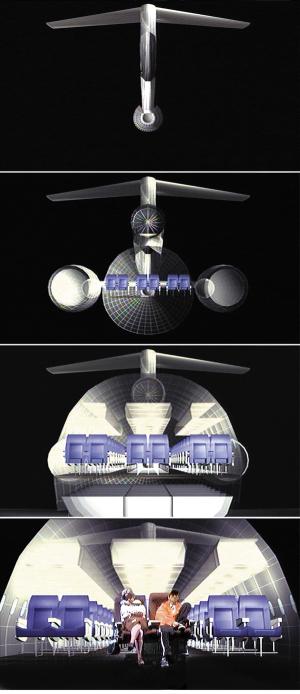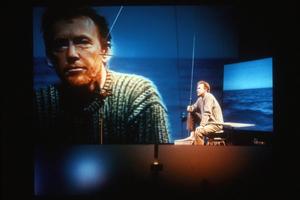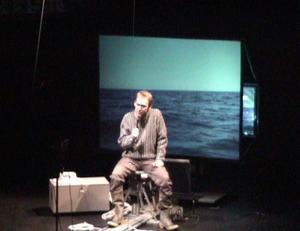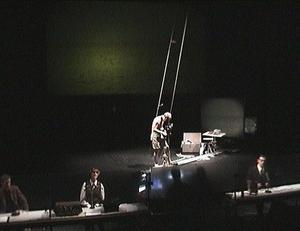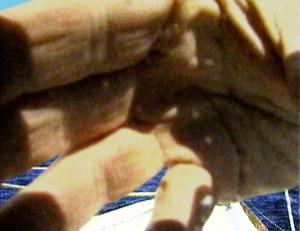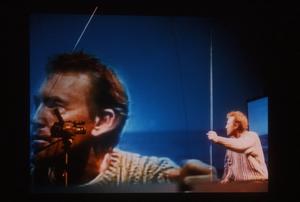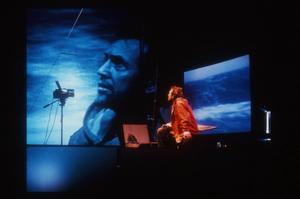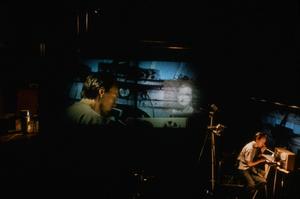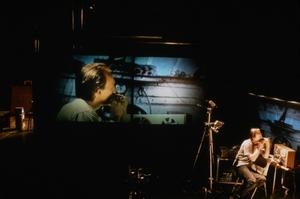JETLAG
MASSMOCA,NORTHADAMS,MASSACHUSETTS
The multimedia theater piece Jet Lag is based on two true stories of heroism involving individuals who were severed from conventional time and space.
In his famous interview “The Third Window,” philosopher Paul Virilio tells the story of Sarah Krasnoff, an American grandmother who flew across the Atlantic 167 times with her young grandson over a period of six months in 1971 in an attempt to elude the child’s father. The two traveled from New York to Amsterdam and from Amsterdam to New York, continuously shuttling back and forth, never leaving the plane or the airport lounge. Krasnoff finally died of jet lag. In the words of Virilio, this contemporary heroine lived in “deferred time.”
In 1969, an eccentric British electrical engineer named Donald Crowhurst joined the Golden Globe Race, the first-ever round-the-world solo yacht race, organized by London’s Sunday Times. Ill prepared for the voyage but motivated by the publicity that the event was guaranteed to generate, Crowhurst set sail with film equipment provided by the BBC to record his journey. Within weeks, he encountered heavy seas in the South Atlantic and aborted the race in its first leg. However, rather than return home, he sailed in circles on the open sea for the remainder of the race. Haunted by the specter of failure, Crowhurst broadcast false positions and produced a counterfeit log documenting a supposed ten-month voyage around the world. He kept a diary charting his mental deterioration and increasingly delusional episodes. As he rejoined the race for the last leg, the fear of social humiliation finally led the troubled sailor to take his life by drowning. Authorities found his boat abandoned off the Azores. Crowhurst ultimately disappeared into his “deferred space.”
Krasnoff was subjected to the generic non-stop space of travel while she produced a virtual home for her grandson in a succession of business lounges and airport hotel rooms; Crowhurst simulated travel while staying in perpetual limbo. This is an inversion of gender stereotypes: the female figure produces a domestic space in perpetual motion while the male fictionalizes motion while frozen in space, confined by the trappings of masculinity and the bravado of movement.
The two stories are told in succession. Both combine live performers and digital technologies in a hybrid theatrical language. On the stage, Crowhurst appears in front of his live video camera. Just behind him is a small video backdrop of a seascape. The projector-and-screen assembly rocks mechanically from side to side to simulate the roll of the ocean. As Crowhurst speaks to the camera, his live image is projected onto the giant screen behind him. The audience witnesses the man and his image as he produces his autodocumentary. Crowhurst rewinds and records new takes until he gets it just right.
Krasnoff appears with her grandson in the banal spaces of air travel — airport lounges, sterile corridors, passport control stations, and security checkpoints. On the stage, the two actors remain all but motionless: the virtual spaces move around them. The live performers are lodged between stage space and virtual backdrops, halfway between past and present.

 Still of motion graphics sequence
Still of motion graphics sequence
| Location Mass Moca, North Adams, United States |
| Team | Elizabeth Diller,Ricardo Scofidio,Lyn Rice,and Patrice Gardera |
| Marianne Weems and Jessica Chalmers | Collaborators |


